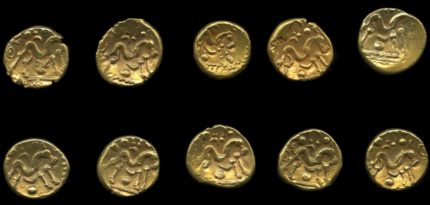Eden Valley Museum in Edenbridge is acquiring an Iron Age hoard of gold coins that was discovered by metal detector hobbyist Jonathan Barber in October of 2016 near the village of Chiddingstone in the Sevenoaks District of Kent, England. The exact find site has not been disclosed for its own protection. The 10 coins were dispersed, not found in a single cluster even though they were buried together. They are believed to have been scattered in later centuries through agricultural activity.
The coins are all of the same type: Gallo-Belgic gold staters minted by the Ambiani tribe of northern France whose main settlement, Samarobriva, is the modern-day city of Amiens. The Ambiani were defeated by Gaius Julius Caesar when he fought the Belgae in 57 B.C. and submitted to him only to join in the uprising against Roman occupation led by Vercingetorix of the Arverni in 52 B.C.
The Ambiani were famed minters, their coins being widely distributed throughout northern France and southern England. The type of coin in the Chiddingstone Hoard is known as a “Gallic War Uniface,” struck during the general time period of Gallic Wars (ca. 60-50 B.C.) in northern France and imported into Britain a few years later. High quality coins made of solid gold, they were in wide circulation in the south of England and a number of them have been found there. Finding a group of ten together, however, is extremely rare.

Interestingly, the obverse is smooth. There is no image or text stamped on it. The reverse features a stylized Celtic horse facing right. Hence the name “Uniface” because there is an image only on one side of the coin. Comparable Iron Age coins struck by Celtic tribes normally had a head on the obverse representing a local ruler or deity. Experts believe the obverse was left deliberately blank as a political message. The Gallic allies fighting against Caesar claimed no sole ruler. They were trying to get rid of one.

The smallest coin in the hoard has a diameter of 15mm. It is also the heaviest, weighing in at 6.16 grams. The largest is 19mm in diameter but is just a hair less heavy at 5.98 grams. The lightest of the coins weighs 5.96 grams and is 18mm in diameter. They’re a remarkably uniform bunch, all in all, with just 4mm and a quarter of a gram variance among them.
When the coins were unearthed, the finder alerted the Kent Finds Liaison for the Portable Antiquities Scheme who recognized the Iron Age gold coins and submitted them for consideration as treasure. One declared treasure, the coins were assessed for fair market value by a committee of experts at the British Museum. Local museums are given first crack at acquiring the treasure for the price of the valuation, a fee which is then split between the finder and landowner.
Claire Donithorn BA, resident archaeologist at the museum said, “These will be our first significant Iron Age exhibits. They date from precisely the time when Britain emerged from Prehistoric to Historic Times. Our aim now is to keep the hoard together and to ensure that it stays in the Valley for us and for future generations.”
Experts in the British Museum examined the coins and identified them. The Eden Valley Museum was then offered the chance to buy them. The Museum leaped at the opportunity. Claire Donithorn said, “These coins are an important part of the history of the Eden Valley. They show that the Valley was connected to great events in European History – the Gallic Wars. Whoever buried them may have been involved in those wars and was probably living here in the Valley.”
The museum needs to raise £13,000 to acquire the coins and to create a secure display for them. Grants from the South East Museums Development Programme, Arts Council England/V&A Museum Purchase Grant Fund and the Headley Trust put £11,315 in the kitty, which gets them almost all the way there. While the fundraising isn’t quite complete, the museum is close enough to move forward with the plan. The Chiddingstone Hoard will go on display starting April 11, 2018.
I wonder how many dies they had, because they all look like they were done with different dies?
Trevor, a tendency to bring “currency”, gold -or any other precious mobile assets- to more or less “save” havens abroad in a hurry, is not at all a modern phenomenon.
If the attic gold stater/ στατήρ from the 5th c. BC was 8.6 g, it makes perfect sense -after the Celtic invasion into Greece- that in the 3rd c. BC the Celtic 1/24 stater was 0.3 to 0.35 g, until later the monetary “switch” to Celtic full staters (like the ‘rainbow cups’ or other staters) was taken.
‘Rainbow cup’, or ‘cup stater’ (German: Regenbogenschüsselchen, Czech: duhovka from duha – rainbow) is a term for Celtic gold coins found in areas once dominated by the La Tène culture. In agriculture, they apparently were ‘turned up’ quite regularly and they even found their way into folklore:
——
“An unnamed, orphaned girl is poor and homeless; she has only her clothing and a loaf of bread […] Finally, as she stands there with nothing left at all, suddenly stars fall to earth before her, becoming talers, and she finds herself wearing a new shift of the finest linen.”
“In 105 BC, the proconsul of Cisalpine Gaul, Quintus Servilius Caepio, reported the discovery of the “cursed” greek gold at Tolosa to the Senate, and was charged with sending the treasure to Rome. Over 50,000 15 lb. bars of gold and 10,000 15 lb. bars of silver were found. The gold disappeared en route, with Strabo mentioning that ‘it was on account of laying hands on them that Caepio ended his life…’ “
——
Caepio did have a son, however, the maternal grandfather of Marcus Junius Brutus, the principal assassin of .. Julius Caesar 😆